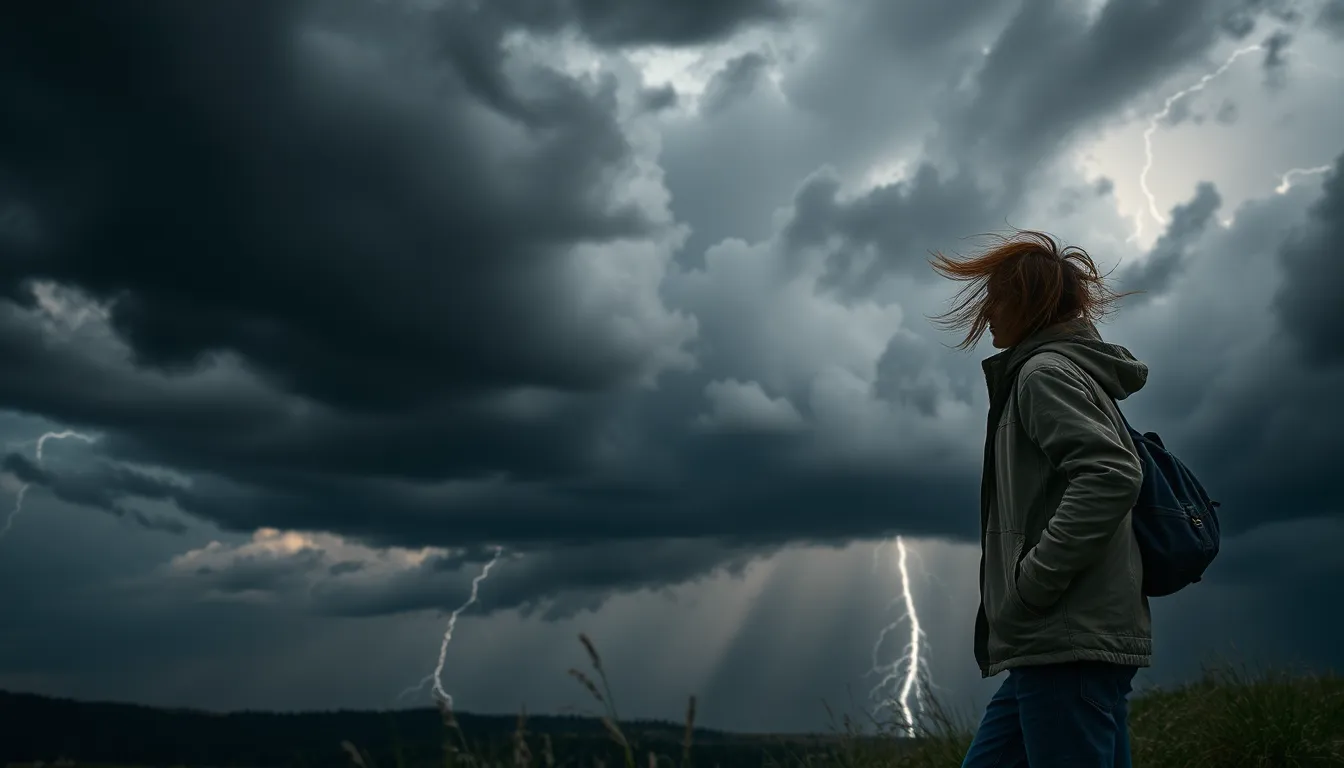Severe weather can strike without warning, leaving chaos in its wake. From hurricanes to blizzards, understanding how to prepare and respond is crucial for safety. With the right strategies, individuals can mitigate risks and protect themselves and their loved ones during these unpredictable events.
This article provides essential tips to navigate severe weather situations effectively. Whether it’s creating an emergency kit or knowing when to evacuate, being informed can make all the difference. Equip yourself with the knowledge needed to face nature’s fury head-on and ensure peace of mind when the skies darken.
Table of Contents
ToggleUnderstanding Severe Weather
Severe weather encompasses a range of atmospheric conditions that can pose significant risks to health and safety. This category includes thunderstorms, tornadoes, hurricanes, floods, and snowstorms, each presenting unique dangers. Understanding the characteristics and potential impact of these events is crucial.
- Thunderstorms: Thunderstorms can produce heavy rain, lightning, hail, and high winds. Over 100,000 thunderstorms occur in the U.S. each year, leading to about 300 fatalities annually.
- Tornadoes: Tornadoes feature rotating columns of air that extend from thunderstorms and can reach speeds over 300 mph. The U.S. experiences roughly 1,000 tornadoes per year, with the most active months spanning April to June.
- Hurricanes: Hurricanes are large storm systems that form over warm ocean waters, characterized by strong winds and heavy rainfall. The Atlantic hurricane season lasts from June 1 to November 30, producing around 12 named storms each year.
- Floods: Flooding occurs when water inundates areas normally dry, often due to heavy rainfall or snowmelt. It’s the leading cause of weather-related fatalities in the U.S., accounting for approximately 90 deaths annually.
- Snowstorms: Snowstorms can disrupt communities with heavy snowfall, strong winds, and low visibility. The Northeast U.S. records an average of 25 inches of snow annually, making snow safety a critical concern during winter months.
Monitoring weather updates and utilizing technology, such as apps and alerts, enhances preparedness. Understanding terms like “watch” and “warning” helps individuals respond appropriately. A “watch” indicates conditions are favorable for severe weather, while a “warning” means severe weather is imminent or occurring.
These insights into severe weather empower individuals to stay safe and make informed decisions during such events.
Types of Severe Weather

Severe weather manifests in various forms, each associated with distinct hazards. Understanding these types enhances preparedness and response strategies.
Thunderstorms
Thunderstorms are intense weather systems characterized by lightning, thunder, and heavy rain. They can lead to flash flooding, hail, and wind gusts exceeding 58 mph. Thunderstorms can pose risks such as downed power lines and road hazards. Monitoring local forecasts and seeking shelter during severe thunderstorms is crucial for safety.
Tornadoes
Tornadoes are violent windstorms forming from supercell thunderstorms. They can produce rotating columns of air reaching wind speeds over 300 mph. Tornadoes cause destruction by uprooting trees, demolishing buildings, and tossing debris. Recognizing the difference between a tornado watch and a warning helps individuals take appropriate precautions.
Hurricanes
Hurricanes are massive storm systems that form over warm ocean waters. They feature sustained winds of 74 mph or greater and can cause extensive flooding, wind damage, and storm surges. Hurricanes typically follow predictable paths, enabling effective tracking and warning systems. Evacuating ahead of a hurricane’s landfall significantly reduces risks associated with this severe weather event.
Preparing for Severe Weather
Preparing for severe weather involves proactive measures to ensure safety and readiness. This section outlines crucial elements in setting up emergency kits and protecting homes.
Emergency Kits
An emergency kit is essential for surviving severe weather events. Assemble a kit that includes these crucial items:
- Water: At least one gallon per person per day for three days.
- Non-perishable food: A three-day supply of items like canned goods, granola bars, and dried fruits.
- Medications: Prescription medications for at least seven days, along with a first aid kit.
- Flashlight: One flashlight per person, with extra batteries.
- Multi-tool: A tool equipped with various functions like cutting and opening cans.
- Important documents: Copies of IDs, insurance policies, and medical records in a waterproof bag.
- Cash: Small bills, as ATMs may not work during severe events.
Regularly check and update emergency kits every six months to ensure all items remain usable and within expiration dates.
Home Protection
Protecting the home against severe weather can minimize damage and enhance safety. Consider these protective measures:
- Secure windows: Use storm shutters or plywood for added protection against high winds.
- Strengthen doors: Reinforce entry doors with metal frames and deadbolt locks.
- Roof maintenance: Inspect for loose shingles and repair any leaks before severe storms hit.
- Clear gutters: Regularly remove debris from gutters to prevent flooding around the foundation.
- Create drainage: Ensure proper drainage by grading the landscape away from the home.
- Install a generator: Having a portable generator can maintain power during outages caused by severe weather.
Implementing these steps can significantly enhance safety and preparedness for any severe weather events ahead.
During Severe Weather
During severe weather, remaining vigilant and informed can significantly impact safety and security. Following these guidelines ensures individuals can navigate through challenging conditions effectively.
Staying Informed
Monitoring weather updates is essential during severe weather events. Individuals should use reliable sources like the National Weather Service (NWS) for real-time alerts. Weather apps provide timely notifications regarding severe conditions, helping to distinguish between watches and warnings. Keeping a battery-powered radio handy allows for continuous updates during power outages. Additionally, following local news stations enhances awareness of developing situations in the area.
Safety Precautions
Implementing safety precautions during severe weather greatly reduces risks. Individuals are encouraged to:
- Seek shelter in sturdy buildings or designated safe areas, avoiding windows and outside doors.
- Use a battery-powered flashlight rather than candles to minimize fire hazards.
- Stay away from floodwaters and avoid driving in flooded areas, as just six inches can sweep away a person.
- Turn off utilities if instructed by authorities or if flooding threatens. This action prevents hazardous situations like gas leaks.
- Prepare for power outages by charging devices and having essential medications on hand.
- Avoid using elevators during severe weather, as they may malfunction or become inoperable.
Following these safety measures can enhance protection and ensure well-being during severe weather events.
After Severe Weather
After severe weather, assessing damage and implementing recovery strategies is crucial for safety and restoration. Individuals and communities must act promptly to address any impacts experienced during the event.
Damage Assessment
Damage assessment involves a systematic evaluation of properties and surroundings. Individuals must:
- Inspect Structures: Check for damages to roofs, walls, and foundations. Look for cracks, leaks, or instability that may pose safety risks.
- Survey Surroundings: Evaluate yards, trees, and roadways for fallen debris or hazards. Identify risks, such as downed power lines or unstable trees.
- Document Damage: Take photos and notes of affected areas. This documentation aids in filing insurance claims and provides records for local authorities.
- Assess Utilities: Check electricity, gas, and water systems for functionality. If there are concerns, it’s important to contact utility providers for guidance.
- Engage Professionals: Consider hiring contractors or inspectors to evaluate severe damages. Experts can offer insight into necessary repairs and safety measures.
Recovery Tips
Effective recovery post-severe weather involves specific actions. Individuals should:
- Contact Insurance Companies: Notify insurers promptly about damages. Provide documentation for swift processing of claims.
- Seek Assistance: Utilize local resources such as disaster relief organizations and government programs. Many offer financial aid and support.
- Follow Safety Precautions: Avoid entering damaged structures until cleared by professionals. Wear protective gear when navigating debris.
- Restore Utilities Safely: Wait for utility companies to confirm system safety before restoring services. Prioritize securing essential services like power and water.
- Create a Recovery Plan: Develop a comprehensive plan that outlines repairs, rebuilding, and financial responsibilities. Set timelines for critical tasks to encourage progress.
Addressing damage and following thorough recovery strategies can facilitate a smoother transition back to normalcy after severe weather.
Severe weather can strike unexpectedly and have devastating effects. By staying prepared and informed, individuals can significantly enhance their safety and the safety of their loved ones. Implementing proactive measures like assembling emergency kits and securing homes is essential.
Moreover, keeping up with real-time weather updates and understanding alerts ensures timely responses to changing conditions. After the storm passes, assessing damage and following recovery strategies can help communities rebuild more effectively.
Taking these steps empowers individuals to face severe weather with confidence and resilience.








